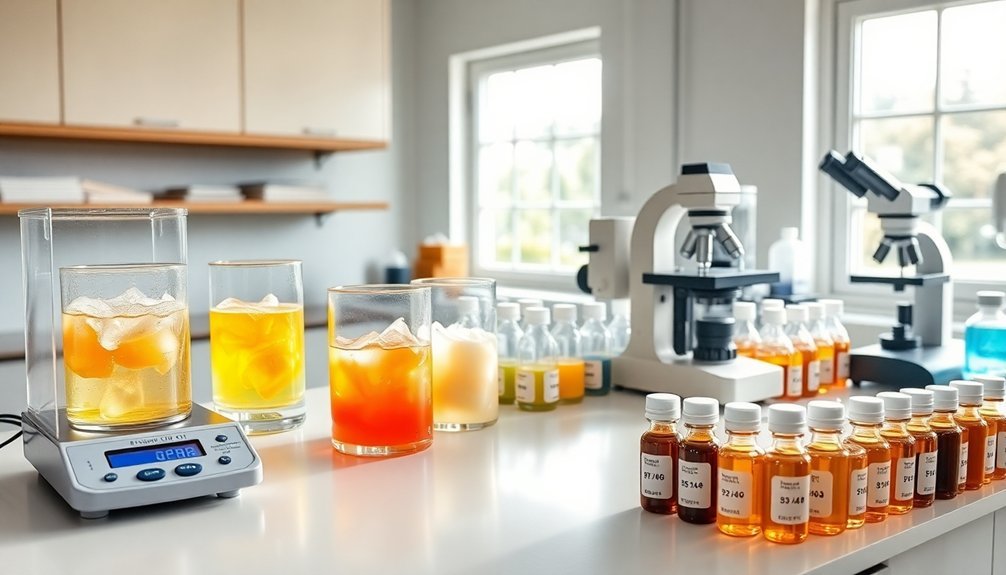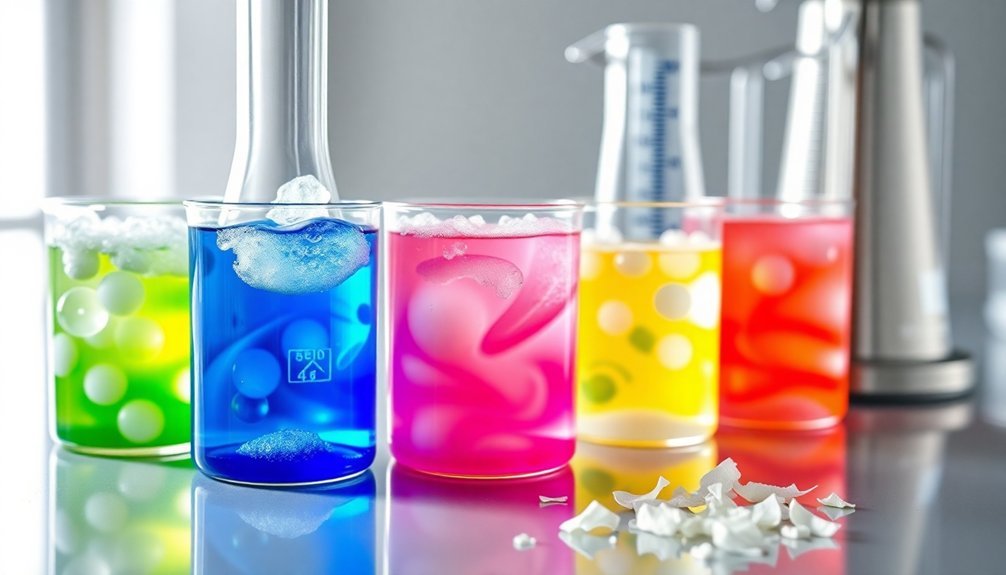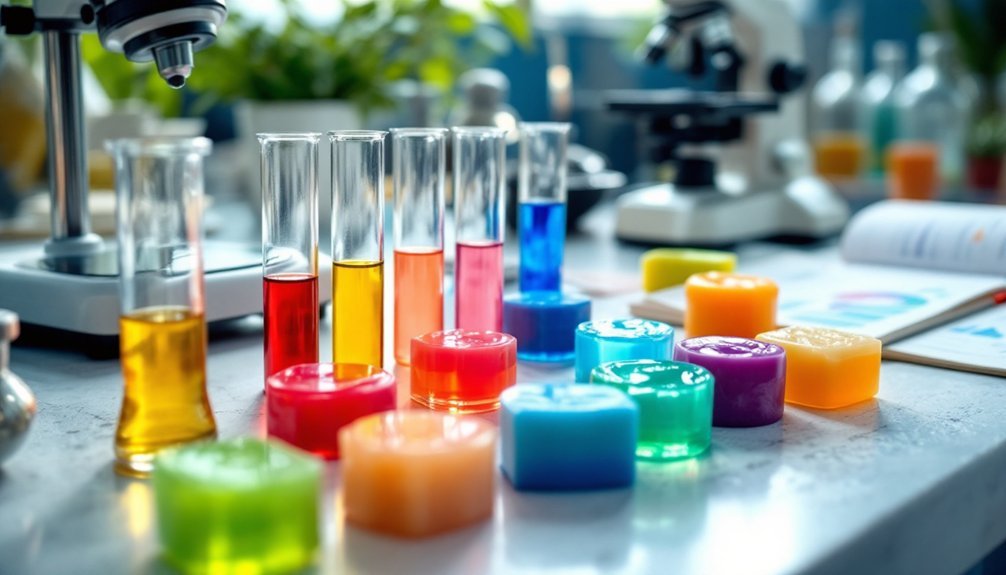Laboratory testing guarantees your handmade soaps meet quality standards and safety requirements. You'll need precision instruments like pH meters, titration equipment, and precision balances to assess essential qualities including pH levels (aim for 8-10), lather formation, cleansing properties, and hard water compatibility. Always wear protective equipment when handling alkaline materials and maintain thorough documentation for certification compliance. The right testing protocols will transform your soap-making from guesswork to science-backed craftsmanship.
Essential Laboratory Equipment for Soap Quality Assessment

Precision instruments form the backbone of effective soap quality testing.
Precision instruments serve as the foundation upon which all reliable soap quality assessments are built.
You'll need titration equipment including burettes and pipettes for acid value testing, along with pH meters to monitor reaction conditions.
For TFM analysis, a Soxhlet apparatus, drying ovens, and precision balances are essential to measure fatty matter content accurately.
Don't overlook moisture testing tools such as digital balances, desiccators, and thermometers.
To evaluate foaming ability, equip your lab with graduated cylinders, stopwatches, and rulers for measuring foam height.
For glycerin content, invest in either HPLC or GC systems, plus spectrophotometers for colorimetric analysis.
These testing procedures help manufacturers ensure their soaps meet the AOCS standards for quality and safety.
Remember to maintain all equipment through regular calibration and cleaning to guarantee your handmade soap testing yields consistent, reliable results.
Ph Testing Protocols and Safety Standards
While creating artisanal soaps may seem like an artistic pursuit, proper pH testing forms the scientific foundation of safe soap production. Your handmade soaps should typically register between pH 8-10 to be skin-safe, with cold process soaps naturally falling around 9-10. Always test fully cured soap using distilled water for accurate results.
When conducting pH tests, follow these essential protocols:
- Use calibrated pH strips or meters to test soap lather (never test raw soap directly)
- Wear protective equipment including gloves and goggles when handling alkaline materials
- Interpret results carefully, adjusting formulations with citric acid if pH reads too high
- Wet the soap thoroughly before testing to ensure the hydrogen ion concentration is accurately measured by your testing tool
Remember that proper pH testing isn't just about quality—it's about ensuring your products won't irritate or harm your customers' skin.
Evaluating Lather Formation and Cleansing Properties

Three key elements define a soap's performance: its lather quality, cleansing power, and skin compatibility. When testing your handmade soaps, you'll need standardized protocols to measure these attributes objectively.
Evaluate lather by examining its stability, volume, texture, and duration—all influenced by your fatty acid profile and additives. The ideal soap produces rich, creamy lather that feels substantial on hands while mimicking the characteristics of shaving cream. Test color transfer to prevent staining and examine bubble structure microscopically for further optimization.
For cleansing properties, measure dirt removal efficiency while monitoring skin irritation potential. Don't overlook rinsability—good soap shouldn't leave residue. Water quality impacts performance considerably, so test your soap in various hardness conditions.
Control testing temperatures carefully and simulate real-world usage scenarios. Compare different formulations to identify how ingredient variations, particularly moisturizing additives and pH buffers, affect overall performance.
Hard Water Compatibility and Emulsification Testing
Understanding how your handmade soaps perform in hard water conditions is essential for developing products that deliver consistent results across different environments.
Effective soapmaking requires understanding your product's behavior across varying water conditions for consistent customer satisfaction.
Hard water contains high levels of calcium and magnesium that react with soap molecules, reducing lather and creating soap scum.
Test your soap's hard water compatibility through these methods:
- Simple Glass Test – Add your soap to a glass of tap water; cloudiness indicates hard water interference.
- Comparative Analysis – Test the same soap in both hard and soft water to observe differences in lathering and emulsification.
- Formulation Adjustments – Add chelating agents to your recipe to bind minerals and improve performance.
For accurate emulsification assessment, observe how well your soap removes oils in hard water conditions, as mineral interactions greatly impact a soap's cleansing abilities. The chemical interaction occurs because calcium ions with positive charges bond with negatively charged soap molecules, resulting in neutral molecules that cannot produce effective lather.
Documenting Test Results for Certification Compliance

Proper documentation of your soap testing results serves as the foundation for certification compliance and business credibility. Follow AOCS standards while guaranteeing you meet local regulations like CPSC requirements in the U.S.
| Documentation Type | Digital Tool | Compliance Purpose |
|---|---|---|
| Acid Value Reports | Craftybase | Product Stability |
| Moisture Content | Electronic DMSs | Shelf Life Claims |
| Ingredient Testing | Compliance Software | Safety Verification |
| Production Records | Inventory Tracking | Manufacturing Consistency |
Maintain consistent documentation styles (MLA or APA) for professional reporting. Consider international compliance if you're selling abroad—this may require document translation and meeting country-specific standards. Implement digital signatures for authentication and secure storage systems to protect sensitive test data. Regular documentation reviews guarantee you're continuously meeting evolving regulatory requirements. For true soaps made from traditional oils and fats, you'll need to include lead testing documentation if your products are marketed for children's use.
Frequently Asked Questions
How Long Should Handmade Soap Cure Before Testing Begins?
You should cure your handmade soap for 4-6 weeks before testing it. If your soap contains high olive oil content, you'll need to wait longer, potentially 6+ weeks for ideal results.
Can Essential Oils Affect Ph Test Results?
Yes, essential oils can affect your pH test results. They'll alter solution pH, especially at higher concentrations. You'll see varying effects depending on the oil type and your soap's other ingredients.
What Temperature Is Ideal for Conducting Soap Lather Tests?
You'll get the best lather test results with water between 26°C and 38°C (80°F-100°F). This range guarantees ideal soap molecule activity while remaining comfortable for handling and producing reliable measurements.
How Do Preservatives Impact Long-Term Soap Quality Testing?
Preservatives enhance your soap's stability in long-term testing by preventing microbial growth that would compromise results. You'll see more consistent performance metrics and shelf-life data when your formulations contain effective preservation systems.
When Should Microbial Testing Be Performed on Handmade Soaps?
You should perform microbial testing on your handmade soaps after full saponification (typically 2-4 weeks), when changing formulations, and regularly thereafter. Don't test too early as alkalinity can cause false positives.
In Summary
You've now got all the tools to properly test your handmade soaps in a laboratory setting. By consistently checking pH levels, lather quality, cleansing efficiency, and water compatibility, you'll guarantee your products meet safety standards. Don't forget to maintain detailed documentation for certification purposes. With these testing protocols, you're ready to create soaps that aren't just handmade, but scientifically validated for quality.





Leave a Reply